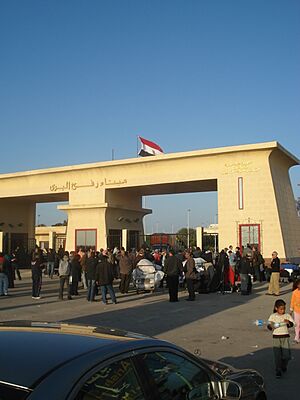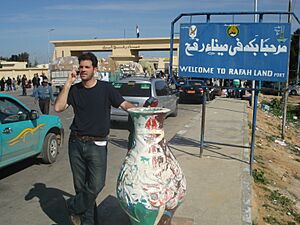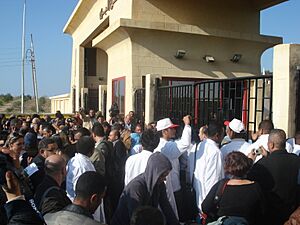Rafah Border Crossing facts for kids
Quick facts for kids Rafah Border Crossingمعبر رفح |
|
|---|---|

Rafah Crossing Point
|
|
| Crosses | Gaza–Egypt border |
| Locale | |
| Maintained by | |
The Rafah Border Crossing (Arabic: معبر رفح, romanized: Ma`bar Rafaḥ) is the only official crossing point between Egypt and the Gaza Strip in Palestine. It is located right on the border between these two areas. Since 2007, Egypt controls the crossing. However, goods coming into Gaza through Rafah usually need approval from Israel.
Contents
What is the Rafah Crossing?
The Rafah Crossing is a very important place. It allows people and some goods to move between Egypt and the Gaza Strip. For many years, different parts of the crossing have been known by different names.
One part, sometimes called the "Salah al Din Gate," is used for trucks carrying goods. This part opened in 2018.
History of the Rafah Crossing
Early Border Agreements
In 1906, an agreement was made between the Ottoman Empire (which ruled Palestine) and the British (who ruled Egypt). This agreement set up the border between these two areas, including the part near Rafah.
Changes After Wars
From 1948, Egypt controlled Gaza. This meant there was no longer a border between Gaza and Egypt. But in 1967, Israel took control of both the Gaza Strip and the Sinai Peninsula from Egypt.
In 1979, Israel and Egypt signed a peace treaty. As part of this treaty, the Sinai Peninsula was returned to Egypt. A 100-meter-wide area, called the Philadelphi Route, was created as a buffer zone between Gaza and Egypt. This new border divided the city of Rafah itself. Families were split, with some living on the Egyptian side and others on the Palestinian side.
Israel Leaves Gaza in 2005
In 2005, Israel decided to remove its settlements from Gaza. This was called Israel's "disengagement plan." After this, Israel closed the Rafah crossing.
Egypt then took control of its side of the border. The Palestinian Authority, which governs parts of Palestine, took control of the Gaza side. The European Union (EU) also helped monitor the crossing. This was to make sure things ran smoothly and safely.
Rules for Movement and Goods
An agreement in 2005 set rules for the Rafah Crossing. The EU was in charge of watching the crossing. This agreement also said that goods could be exported from Gaza to Egypt.
However, most goods coming into Gaza had to go through another crossing called Kerem Shalom border crossing. This was because Israel was worried about how customs rules would be followed at Rafah. This led to people using tunnels to bring goods into Gaza.
In 2005, the crossing opened under EU supervision. The Israeli army watched from a distance. They still controlled the movement of all goods in and out of Gaza.
By 2018, goods regularly entered Gaza from Egypt through Rafah. In 2022, about half of the goods entering Gaza came from Egypt through Rafah. Most of these goods were building materials and food.
During the 2023 Israel–Hamas war, the Palestinian side of the Rafah crossing was bombed. This made it hard for aid to get in and people to get out. Egypt asked for promises that aid convoys would not be attacked.
How Many People Cross?
After Israel left Gaza in 2005, about 40,000 people crossed Rafah each month. But after an Israeli soldier was captured in 2006, the crossing was closed most of the time. When Hamas took control of Gaza in 2007, it was almost always closed.
From 2010 to 2011, about 19,000 people crossed each month. After Egypt's President Hosni Mubarak was replaced in 2011, this number grew to 40,000 per month. But when the new president was removed in 2013, the crossing was closed again.
In 2014, the United Nations World Food Programme was allowed to bring food through Rafah for the first time since 2007. This food helped about 150,000 people. In 2014, about 8,119 people crossed each month. By 2015, this number dropped to about 3,300, even though Gaza had 1.8 million people.
Why the Border Closes
Closures from 2005 to 2007
From 2005 to 2007, Egypt and the Palestinian Authority controlled the Rafah Crossing together. The EU watched over the Palestinian side. The crossing was open daily until June 2006. Israel then issued security warnings, which stopped EU monitors from reaching the crossing.
In June 2006, an attack happened at another crossing, and an Israeli soldier was captured. After this, Rafah was opened only sometimes.
In 2007, the EU worried about Israel closing the crossing often. They even stopped ambulances from moving through Rafah easily.
In June 2007, Egypt closed the Rafah Crossing after Hamas took control of the Gaza Strip. The EU monitors left because it was not safe. Egypt and Israel agreed to keep the crossing shut.
Closures from 2007 to 2010
In January 2008, after Israel closed all crossings to Gaza, Hamas supporters tried to force open the Rafah Crossing. They broke down part of the border wall. Many thousands of Palestinians then crossed into Egypt to buy food, fuel, and other goods. On February 3, 2008, Egypt closed the border again, except for people returning home.
In 2009, Hamas suggested a plan to keep the Rafah border crossing open all the time. They welcomed European, Egyptian, and Palestinian guards.
A report in 2009 said that Israel still controlled who could go through Rafah. This was because Israel controlled the Palestinian population records. Israel could also stop foreigners from crossing and close the crossing whenever it wanted.
Closures from 2011 to 2013
Before 2011, the Egyptian government under President Mubarak did not support Hamas and helped Israel keep the blockade. But after the 2011 Egyptian revolution, Mubarak left power.
In April 2011, Fatah and Hamas made an agreement. Egypt then announced that the border crossing would open permanently. On May 28, 2011, the crossing reopened. Most travel rules were relaxed, but some men still needed visas or travel permits. The crossing was now guarded by Hamas police.
In July 2013, after a change in Egypt's government, the crossing was closed for several days. It later reopened for only four hours a day. After more unrest in Egypt in August, the crossing was closed "indefinitely." Since then, it has only opened for a few days every few months.
Closures from 2013 to 2020
After the 2014 Israel–Gaza conflict, Egypt offered to train Palestinian guards to manage the Rafah Crossing. Egypt hoped this would lead to a Palestinian state. Palestinian groups in Gaza, including Hamas, agreed to let these guards and the EU mission return.
In January 2015, Egypt closed the border again. In March, Egypt said it would only open the crossing if Palestinian Authority employees were in charge, with no Hamas staff present.
However, Egypt still allowed some supplies to cross into Gaza through Rafah, like fuel for Gaza's power plant in 2017 and gas in 2018.
In May 2018, Egypt opened the crossing, allowing hundreds of Gazans to cross into Egypt each day. By July 2019, tens of thousands had left for other countries.
In March 2020, Palestinian authorities closed the crossing to stop the spread of COVID-19 in Gaza. In November 2020, Egypt closed the crossing to vehicles and goods due to issues with Hamas.
Closures from 2021 to Present
In February 2021, Egypt opened the crossing "indefinitely" for the first time in years. This was to help talks between Palestinian groups. The crossing stayed open during and after the 11-day conflict in May 2021, bringing in aid and building materials. Egypt closed the crossing again in August 2021 after problems between Israel and Hamas. It later partly reopened for traffic going from Egypt to Gaza.
In October 2023, with the start of the 2023 Israel–Hamas war, the crossing was mostly sealed. For several weeks, it was very difficult for people or aid to cross. Egypt said it kept the crossing open for aid and foreign nationals, but blamed Israeli air strikes on the Gaza side for keeping it closed. On October 21, the border opened for humanitarian aid to enter Gaza. On November 1, a small number of foreign nationals and injured people were allowed to leave Gaza through the crossing.
In 2024, Israel took control of the crossing during the Rafah offensive. In response, Egypt closed its side of the crossing. Egypt said the crossing should only be managed by Palestinian authorities.
See also
 In Spanish: Paso de Rafah para niños
In Spanish: Paso de Rafah para niños




